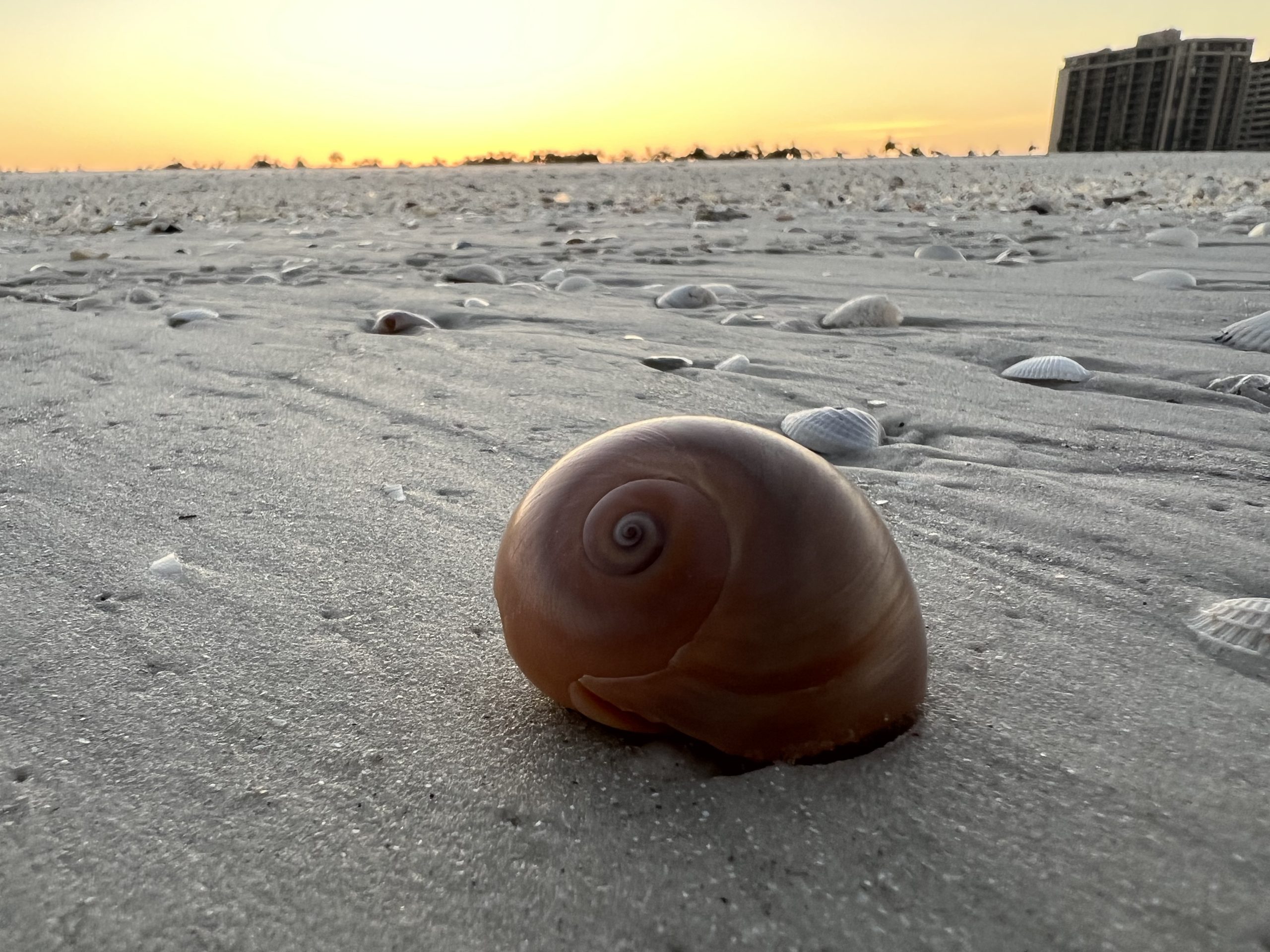As a Florida Master Naturalist and Local Shelling Expert with Treasure Seekers Shell Tours, I am privileged to guide enthusiastic shell seekers through the stunning landscapes of the Ten Thousand Islands. Shelling on Marco Island is a truly unique experience, thanks to the island’s rich biodiversity and pristine beaches. In this blog post, I will share my top five shelling spots on Marco Island, enriched with scientific details and intriguing facts to enhance your shelling adventure.
1. Tigertail Beach
Why It’s Special:
Tigertail Beach is renowned for its incredible shell diversity and beautiful landscapes. The lagoon that separates the beach from the Gulf of Mexico creates a unique environment that attracts a wide variety of marine life.
What to Look For:
- Sand Dollars: These flat, burrowing echinoderms are abundant in the shallow waters of the lagoon. They have a distinctive flower pattern on their exoskeleton.
- Junonia Shells: Rare and highly prized, these shells have a distinctive spotted pattern and are considered a trophy find among shell collectors.
Scientific Details:
- Sand Dollar (Echinarachnius parma): Sand dollars are related to sea urchins and starfish. They use tiny spines on their underside to burrow and move through the sand.
- Junonia (Scaphella junonia): This deep-sea mollusk is usually brought ashore by strong currents and storms, making it a rare find on the beach.
2. South Marco Beach
Why It’s Special:
South Marco Beach is easily accessible and less crowded, making it a favorite among locals and tourists alike. Its wide sandy shores and clear waters are perfect for finding a variety of shells.
What to Look For:
- Lightning Whelks: Known for their unique left-handed spirals, these large shells are a striking find.
- Banded Tulips: With their beautiful, banded patterns, these shells are both common and captivating.
Scientific Details:
- Lightning Whelk (Sinistrofulgur sinistrum): The lightning whelk is a predatory sea snail that feeds on bivalves. Its left-handed spiral is a distinctive feature among gastropods.
- Banded Tulip (Cinctura lilium): This carnivorous mollusk preys on other snails and bivalves. It has a smooth, elongated shell with beautiful brown and white bands.
3. Hideaway Beach
Why It’s Special:
This hidden gem is a private beach accessible to residents and guests of the Hideaway Beach Club. Its secluded location means fewer people and more shells.
What to Look For:
- Olive Shells: These smooth, shiny shells are a delight to find and come in various shades of brown and gray.
- Cockles: With their heart-shaped, ridged shells, cockles are easy to spot and collect.
Scientific Details:
- Olive Shell (Oliva sayana): Olive shells are active predators that burrow in the sand to hunt for small invertebrates. Their shells are often polished to a high shine by the sand.
- Cockle (Cardiidae family): Cockles are bivalves with robust, ribbed shells. They are filter feeders, sifting plankton and other nutrients from the water.
4. Keewaydin Island
Why It’s Special:
Keewaydin Island is an undeveloped barrier island accessible only by boat, making it a pristine location for shelling. Its remote nature ensures that the beaches are filled with shells.
What to Look For:
- Murex Shells: These ornate shells are a spectacular find with their spiny exteriors.
- Scotch Bonnets: These beautiful, round shells with a pattern of squares are a rare treat for shell collectors.
Scientific Details:
- Murex (Muricidae family): Murex snails are carnivorous and known for their elaborately spined shells, which help protect them from predators.
- Scotch Bonnet (Semicassis granulata): The scotch bonnet is the state shell of North Carolina and is known for its thick, rounded shell with a distinctive pattern.
5. Cape Romano
Why It’s Special:
Famous for its dome houses, Cape Romano offers a unique shelling experience. The area is rich in marine life due to the convergence of freshwater and saltwater ecosystems.
What to Look For:
- Horse Conchs: These large, orange-colored shells are impressive finds.
- Angel Wings: Delicate and beautiful, these shells are named for their resemblance to angel wings.
Scientific Details:
- Horse Conch (Triplofusus giganteus): The horse conch is the largest gastropod in the Gulf of Mexico. It preys on other large mollusks and can grow up to 24 inches in length.
- Angel Wing (Cyrtopleura costata): Angel wings are burrowing bivalves that live in muddy or sandy substrates. Their delicate, elongated shells are easily recognizable.
Shelling Tips and Best Practices
1. Timing is Everything
The best time for shelling is during low tide, especially after a storm. Early morning or late afternoon shelling can yield the best finds.
2. Equip Yourself
Bring a mesh bag or bucket for collecting shells, and don’t forget sunscreen, water, and a hat. A small shovel or scoop can be handy for digging up buried treasures.
3. Respect the Environment
Only collect empty shells to ensure that you’re not disturbing live creatures. The Ten Thousand Islands is a delicate ecosystem, and it’s essential to practice ethical shelling.
4. Know Your Shells
Familiarize yourself with the local shells. This knowledge will enhance your experience and help you identify your finds accurately.
5. Join a Guided Tour
Consider joining a guided shelling tour with Treasure Seekers Shell Tours. Our experienced guides will take you to the best spots and share fascinating insights about the local marine life.
Conclusion
Marco Island and the surrounding Ten Thousand Islands offer some of the best shelling experiences in Southwest Florida. Whether you’re a seasoned collector or a novice sheller, these top spots provide an abundance of beautiful and unique shells. Join us at Treasure Seekers Shell Tours to explore these incredible locations and discover the wonders of shelling. For more information and to see our adventures, check out our YouTube channel.
#Shelling #MarcoIsland #ShellTours #TenThousandIslands #FloridaShelling #EcoFriendlyTours #LightningWhelk #JunoniaShell #BestShellingSpots #TreasureSeekersShellTours #CollectingShells #MarineLife #FloridaMasterNaturalist #SouthwestFlorida #Beachcombing
